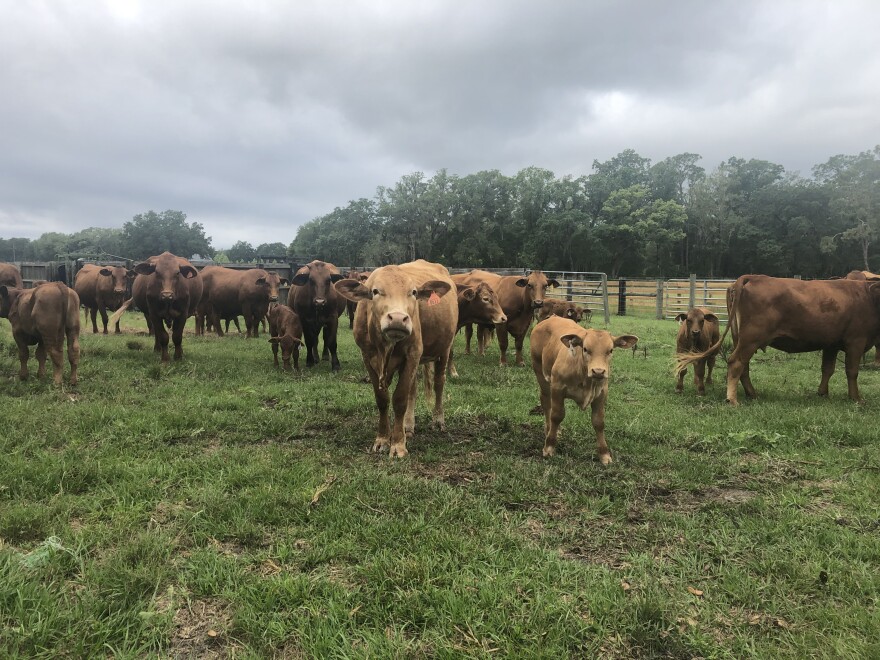Vampire bats could soon make their way into the United States from Mexico due to climate change and development, scientists say.
The possibility of a migration is concerning federal agriculture officials because the bats like to feast on the blood of large farm animals, while sometimes spreading rabies.
Florida is number three on the list of places where the bats could be headed in coming years.
There are three species of vampire bats that feed on large animals, like cattle, and only one species that can carry rabies. They reside mainly in Latin America right now, but Toni Piaggio, a scientist with the U.S. Department of Agriculture, said that could soon change.
“What we found is that there's a clear signal of population expansion on the northern end of their distribution, specifically, in Mexico,” she said.
Vampire bats have been documented in Mexico just over 30 miles from the U.S. border. They don’t typically migrate, Piaggio said, but rising temperatures from global warming are creating more habitat for them to the north. Research-based models suggest Texas, Arizona, and Florida currently have suitable habitats for the creatures. An increase of development in their native habitat also has the bats on the move.
So far, there have been no reports of vampire bats in the U.S., but experts believe the first likely place for them to end up is Southern Texas. Cuba is second on the list and Florida is third. Piaggio said they could be blown in by storms or catch a ride on a shipping container.
“The biggest concern about vampire bats and livestock is the transmission of pathogens, and specifically rabies.” said Piaggio.
She said this is a particular problem in Central America and South America.
“The risk of the transmission of rabies to the cattle is a huge and important impact in the economy,” said Luis Lecuona, an agricultural specialist with the USDA in Mexico City who focuses on wildlife diseases.
He said if young unvaccinated animals become infected with rabies, they will die.
“In fact, that is one of the main indicatives that the vampires are present in an area,” Lecuona said.
For some small-scale ranchers there, livestock deaths can be financially devastating.
Mexico has launched national campaigns to vaccinate cattle and other farm animals in affected areas, Lecuona said. In the past five years, Mexico has spent about $2.7 million per year to fight paralytic rabies. There are also some monitoring and education programs in place.
About 20 years ago, Lecuona said vampire bats were recorded in 25 Mexican states. Now, they are in 27 states, including Nuevo León, which is close to the Texas border.
In September 2020, USDA APHIS Wildlife Services held a virtual panel of federal and state employees to start strategizing around the possibility of vampire bats entering the United States.
“Everybody thought it was about a 60% chance that within the next 20 years, there could be a vampire bat documented, but that doesn't necessarily inherently mean anything that is something to be concerned about,” said Toni Piaggio.
The Florida Fish and Wildlife Conservation Commission was a part of that two-day workshop. In an email, a spokesperson said it’s not likely the creatures will make it to Florida.
“Vampire bats are not strong flyers,” said an FWC spokesperson via email. “So, it is also unlikely they would be able to migrate from Mexico to Cuba and then from Cuba to Florida because of the distances they would have to fly over water to do that.”
However, the agency does plan to keep working with the USDA and is open to establishing vampire bat monitoring, educational and outreach programs, if needed, the spokesperson said.
The USDA will continue hosting meetings with state and federal scientists and health officials. Another virtual gathering is expected later this year.
Meanwhile, Pasco County cattle rancher Kevin Escobar has not yet heard anything about vampire bats within his circles. Still, he said it’s a good thing that officials are keeping an eye on the future health of the cattle industry.
“As things continue to evolve and grow, there will always be new changes that we have to adapt to in order to keep our herds healthy to provide a safe and healthy food supply for the consumer,” Escobar said.
While the bats could be deadly for cattle, experts say they pose little threat to humans. Of course, there are exceptions and their appetite for the blood of livestock can put them in close proximity to humans.
Copyright 2021 WUSF Public Media - WUSF 89.7. To see more, visit WUSF Public Media - WUSF 89.7. 9(MDAyNDY5MjM1MDEyODE2MzMyMTZmZDQwMg001))









